Best Fundraising Platforms in 2025
Explore the best online fundraising platforms in 2025 for nonprofits, creators, and communities. Compare features, fees, and discover how Scrile Connect lets you build a fully branded, customizable fundraising platform that’s truly your own.
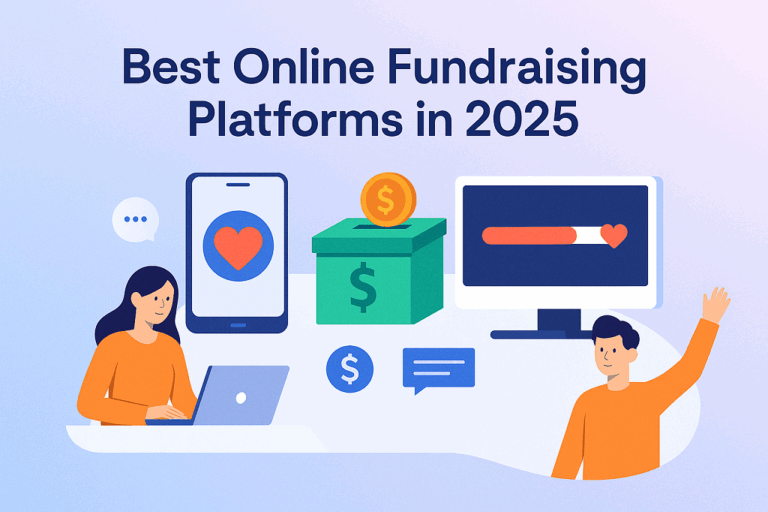
best online donation platforms for nonprofits
Fundraising in 2025 doesn’t look like it used to. It’s no longer about pleading for support — it’s about inviting people into an experience. Whether you’re a nonprofit on a mission, a content creator rallying fans, or a parent crowdfunding for your child’s surgery, the landscape has changed. The best online fundraising platforms aren’t just donation jars with buttons — they’re immersive, social, and built to connect. Livestream events, AI-powered donor chats, paywalled content, and exclusive merch drops are becoming standard. Campaigns are looking more like interactive fan hubs than traditional appeals.
And the numbers prove it’s working. Global online giving is on track to surpass $20 billion this year. Mobile now accounts for nearly 60% of donation activity, and donors expect more than a static page with a “donate” button. They want stories. Interactions. Transparency. A reason to stay involved beyond a one-time gift.
In short, the platforms that thrive in 2025 don’t just collect money — they build movements. This article walks you through the top tools out there, how to choose what fits, and what to do if you’ve outgrown the templates everyone else is using.
What the Best Online Fundraising Platforms Have in Common

When you’re choosing a platform to fundraise on, it’s tempting to go with whatever’s most familiar — the name you’ve heard before or the first result on Google. But familiarity doesn’t always equal fit. The best online fundraising platforms in 2025 share a set of qualities that go far beyond name recognition. If your chosen tool doesn’t tick most of these boxes, it’s probably holding you back.
Transparent Fees, or Better Yet — None at All
Let’s be real. No one wants to lose 5% of every donation to platform fees, especially when margins are tight. The most competitive fundraising platforms now either offer clear, low-cut pricing or run on optional tipping models — where donors choose to support the platform, not you. If fees are buried in fine print or change based on how “premium” your campaign is, run.
Mobile-First, or You’re Losing Donors
Most donors aren’t sitting at a desktop when they give. They’re on a phone, in line at the store, swiping through social media. The top platforms optimize donation flows for mobile by default — fast-loading pages, autofill for payments, easy sharing. If it takes more than 30 seconds to give, you’ve probably lost someone.
Built for More Than Just Donations
One-time gifts are nice. But best online fundraising platforms go further. They support peer-to-peer fundraising, where your supporters raise money on your behalf, plus tools for live events, team-based goals, and donor engagement over time. Some platforms even let you gamify giving or build tiered supporter experiences.
Balance Between Simplicity and Customization
You shouldn’t need a developer to launch a campaign. But you should have the freedom to make it feel like yours. The best platforms give you the essentials to start fast — and the flexibility to grow. That means custom branding, donor tagging, integration with your CRM or newsletter, and modular add-ons.
Future-Ready Features
Fundraising is evolving fast. Platforms that stay ahead of the curve now include AI-driven donor communication, live video integrations, and even membership-style monetization. If your tool feels frozen in 2018, it’s probably costing you more than you realize.
Platform Breakdown: Top Contenders in 2025
So you know what makes a great platform — now let’s talk names.
We dug into the most popular and emerging fundraising platforms being used right now, from household names like GoFundMe to more specialized tools like BetterWorld and Give Lively. These aren’t just the biggest platforms — they’re the ones that are actually helping people raise money, grow communities, and get results in 2025.
Each one comes with its own strengths and trade-offs. Some are built for speed. Others for scale. And a few are trying to reinvent what fundraising looks like entirely. Your ideal fit depends on who you are, what you’re trying to fund, and how much control you want over the process.
Here’s how they stack up — plain and simple.
GoFundMe — Best for Fast, Public-Facing Campaigns
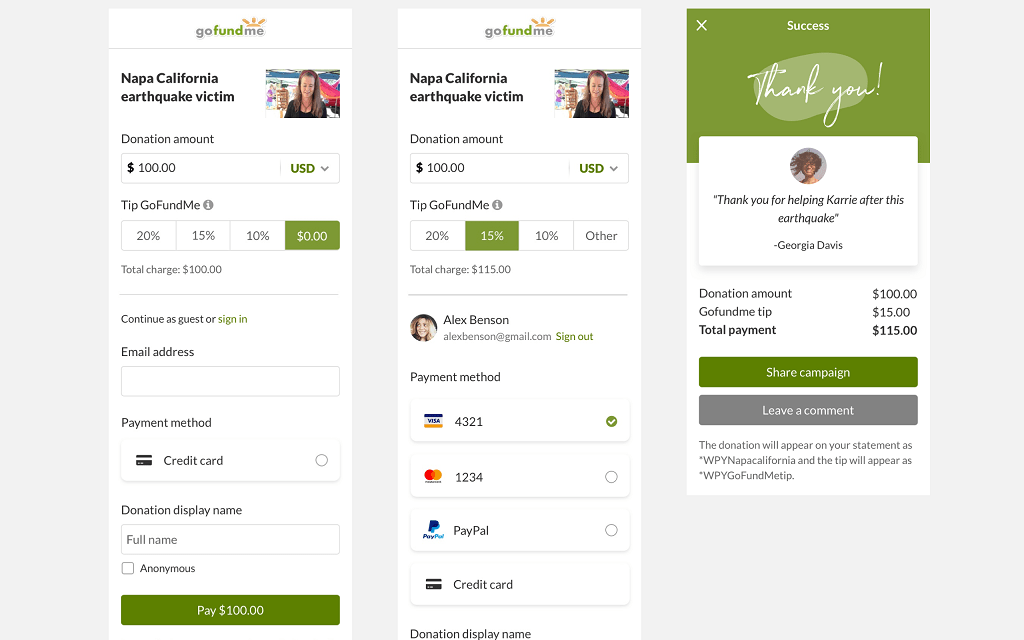
GoFundMe is probably the most well-known name in online fundraising — and for good reason. It’s dead simple to set up, and it’s built for visibility. If you’re running a time-sensitive campaign — a medical emergency, a crisis response, or a local need that can spread fast on social media — GoFundMe gets the job done.
It’s not flashy, and you won’t find many bells and whistles. But it works. And most importantly, people trust it. In fact, GoFundMe users raise around $50 million per week, with more than 150 million people having donated through the platform to date.
Strengths
- Instant name recognition and credibility
- Easy to set up — takes minutes
- Built-in tools for sharing updates and thanking donors
- Integrated social sharing and email outreach
- Donors can leave comments and boost visibility
Downsides
- Not ideal for organizations needing advanced tools or branding
- 2.9% + $0.30 transaction fee on every donation
- Very limited customization — you’re stuck in GoFundMe’s ecosystem
- Doesn’t support peer-to-peer or recurring giving out of the box
BetterWorld — Best for Creative, Zero-Fee Fundraising
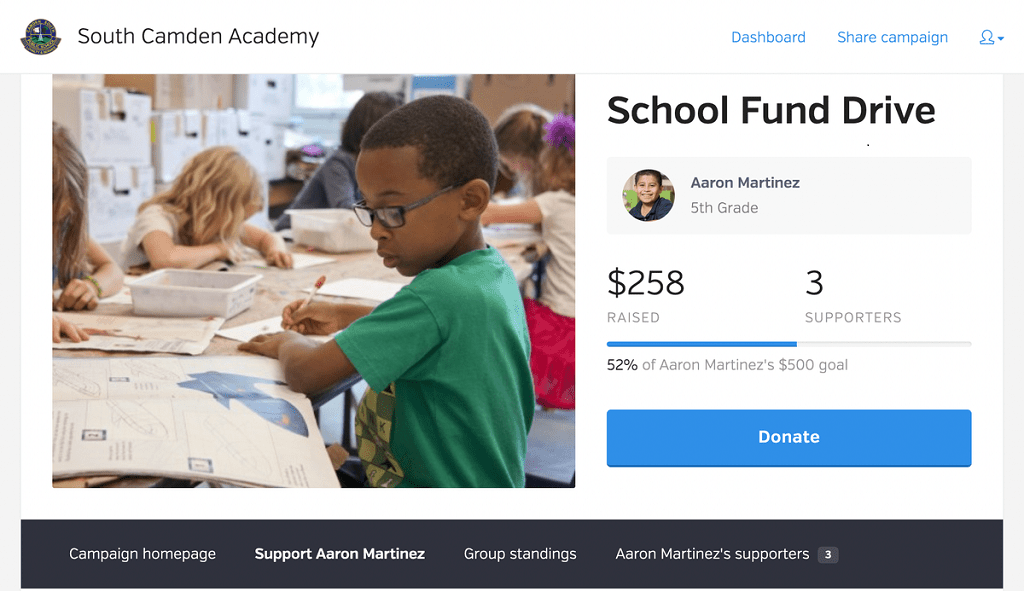
BetterWorld quietly carved out its space as one of the most flexible fundraising platforms available — and here’s the kicker: it’s completely free. No platform fees. No hidden charges. The company runs on a tip-based model, so all your campaign revenue goes to your cause.
BetterWorld shines when your campaign needs something beyond basic donations. Want to run a giveaway? Host an online auction? Set up a branded sweepstake with digital rewards? It’s all possible without needing to stitch together different tools.
Strengths
- Zero platform fees — seriously
- Supports raffles, auctions, events, giveaways
- Fast setup with sleek templates
- Custom branding options available
- Peer-to-peer fundraising supported
Downsides
- Less known than GoFundMe — may need more effort to build trust
- No built-in livestreaming or multimedia features
- Branding options are decent, but not fully white-label
- Doesn’t support advanced CRM or donor segmentation
Donorbox — Best for Nonprofits That Want to Grow
Donorbox is a favorite among growing nonprofits — especially those looking for recurring donations and CRM-level control without needing enterprise software. It integrates easily with your website (via embedded forms or pop-ups) and plays nicely with tools like Mailchimp, Salesforce, and Zapier.
It’s used by over 50,000 organizations worldwide, and while it’s not as plug-and-play as GoFundMe, it gives you much more room to operate strategically over time.
Strengths
- Built-in support for recurring donations and donor tiers
- Embeddable forms for your existing website
- Excellent integrations with CRM and email marketing platforms
- Great reporting and analytics dashboard
- Transparent pricing: 1.5% platform fee (plus payment processing)
Downsides
- Setup is a bit more technical than casual platforms
- Not ideal for one-off fundraisers or beginners
- Design customization is limited without developer help
- Extra features can feel gated behind upgrades or third-party tools
Givebutter — Best for Social, Video-First Campaigns
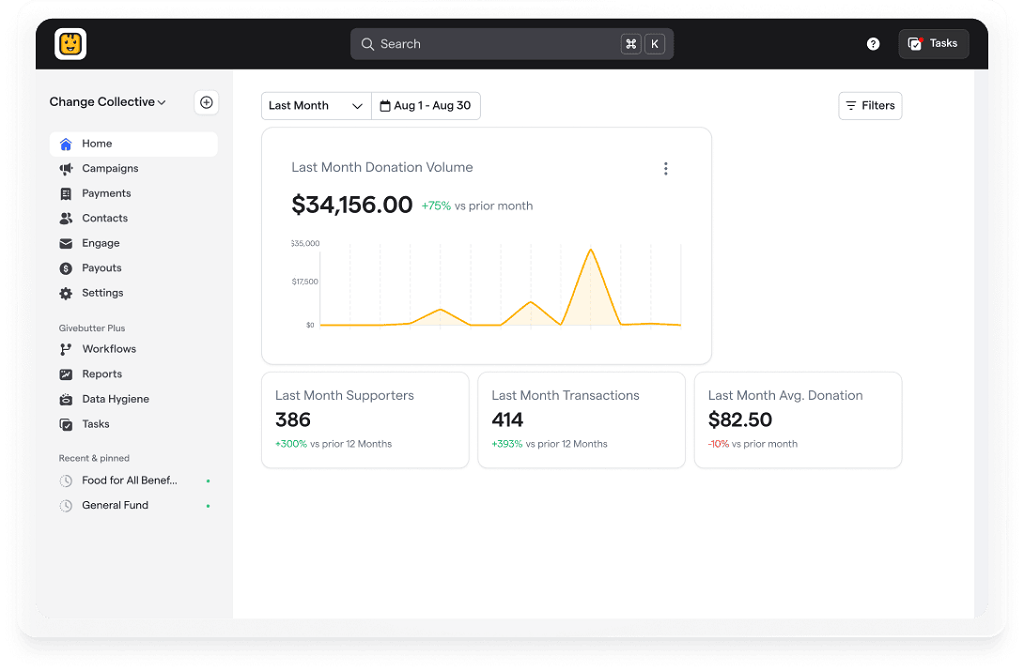
Givebutter is a newer player, but it’s grown fast — and for good reason. It feels like a hybrid between a fundraising platform and a social app. It’s built to be shared, to look good on mobile, and to keep donors engaged with videos, emojis, updates, and even livestreams.
Unlike some tools that feel like clunky donation forms, Givebutter campaigns actually look and feel fun. It’s especially popular with schools, student organizations, and grassroots campaigns that need energy and momentum from the crowd.
Strengths
- Built-in livestreaming and video support
- Accepts Venmo, PayPal, Apple Pay, cards — huge for Gen Z donors
- 0% platform fee (runs on optional tipping)
- Real-time donor feeds and progress bars
- Great for peer-to-peer and team fundraising
Downsides
- Branding is somewhat limited (Givebutter logo sticks around)
- Not ideal for large nonprofits needing CRM-level integration
- UI feels youth-focused — may not suit formal campaigns
- Some features gated behind paid plans
Classy — Best for Large-Scale, Enterprise Nonprofits
Classy isn’t trying to be scrappy or playful. It’s a professional-grade system built for nonprofits that are already operating at a higher level. If you’ve got a full development team, complex donor pipelines, or multi-channel fundraising campaigns, Classy gives you the muscle to manage it all.
It supports everything from event ticketing to recurring giving to corporate partnerships. But this power comes with a price — and a learning curve. Still, for larger orgs, it’s a proven solution backed by a solid reputation.
Strengths
- Advanced analytics, donor segmentation, and reporting
- Excellent for event-based fundraising and gala management
- Supports recurring donations, branded pages, and campaign cloning
- Used by high-profile nonprofits across multiple sectors
- Built-in integrations with Salesforce and major CRMs
Downsides
- Requires a subscription — not cheap
- Takes time to learn and implement effectively
- Not ideal for small or ad hoc fundraisers
- Interface can feel overly complex for basic needs
Give Lively — Best for Small Orgs That Want Big Features for Free
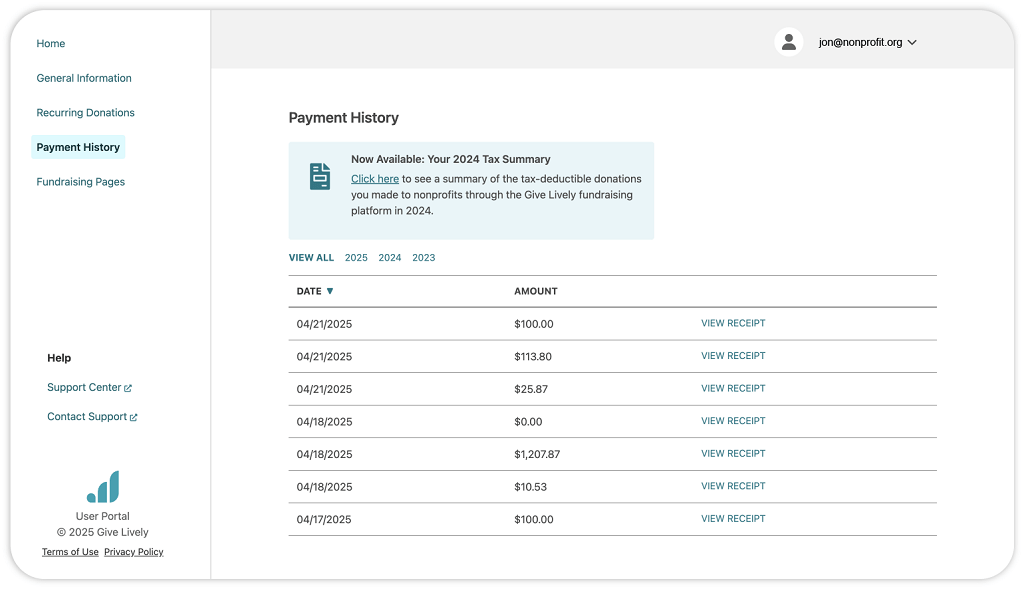
Give Lively is a nonprofit platform that supports… nonprofits. Unlike most platforms funded by VCs or backed by corporations, Give Lively is funded by philanthropists — which means they can offer their platform to other nonprofits entirely for free.
Don’t let the price tag fool you. Give Lively comes with strong tech: text-to-donate, peer-to-peer campaigns, event ticketing, even video storytelling. It’s a huge asset for small-to-mid organizations with tight budgets but big ideas.
Strengths
- 100% free to use — no platform fees
- Supports text giving, custom donation pages, and video integration
- Integrates with Salesforce, Stripe, and other tools
- Great for building donor trust and recurring gifts
- Designed specifically for mission-driven orgs
Downsides
- Limited design customization unless you embed everything manually
- No white-label or full branding control
- Doesn’t support creators, individuals, or for-profit use
- Support and onboarding can be slower than commercial platforms
Facebook Fundraisers — Best for Built-In Reach and Social Sharing
Facebook may not be the first platform that comes to mind when you think of fundraising platforms, but it’s still one of the most effective — simply because of the audience it commands. With nearly 3 billion monthly active users, the potential reach is enormous, and you don’t need to drive traffic anywhere else. Your donors are already on the platform.
Fundraising on Facebook works best when your supporters are willing to spread the word. Campaigns gain traction through likes, shares, and personal posts. And because Meta waives its platform fee for most causes, 100% of donations go directly to the organization.
Still, while it works great for visibility, Facebook fundraising comes with real limitations. You don’t control the branding, layout, or even the donor list (you might not even get the donors’ emails). That means long-term donor relationships are harder to build — you’re working within Facebook’s walled garden.
Strengths
- Massive built-in audience — no need to send donors elsewhere
- 0% platform fee for nonprofit campaigns
- Easy to share, tag, and promote across the platform
- Great for birthday fundraisers, memorial drives, and quick-response giving
- Simple to set up, manage, and promote — anyone with a profile can run one
Downsides
- Minimal control over design, layout, or campaign content
- No access to full donor data unless users opt in
- Not ideal for long-term relationship building or complex campaigns
- Limited analytics and no integrations with external tools
- You’re always at the mercy of Facebook’s algorithm — which can tank reach overnight
Wrapping Up the List: It’s Not Just About Features, It’s About Fit
So, what did we learn?
There’s no single “best” platform that works for everyone. GoFundMe is great for urgent public appeals but lacks customization. BetterWorld is a creative’s dream — if you’re comfortable building trust with your audience. Donorbox is the workhorse of growth-stage nonprofits, while Givebutter brings fundraising into the social-media era. Classy is built for heavy-hitters, Give Lively supports mission-first orgs with no strings attached, and Facebook makes use of your existing network — but at a cost to control.
What they all offer is a way to plug in and get going fast. But if you’re finding those limits — if you’re trying to build something more than just a page with a “Donate” button — then the next section is for you.
We’re about to talk about what happens when you stop using someone else’s tool… and start building your own.
Real Use Cases — What Successful Fundraisers Are Doing in 2025
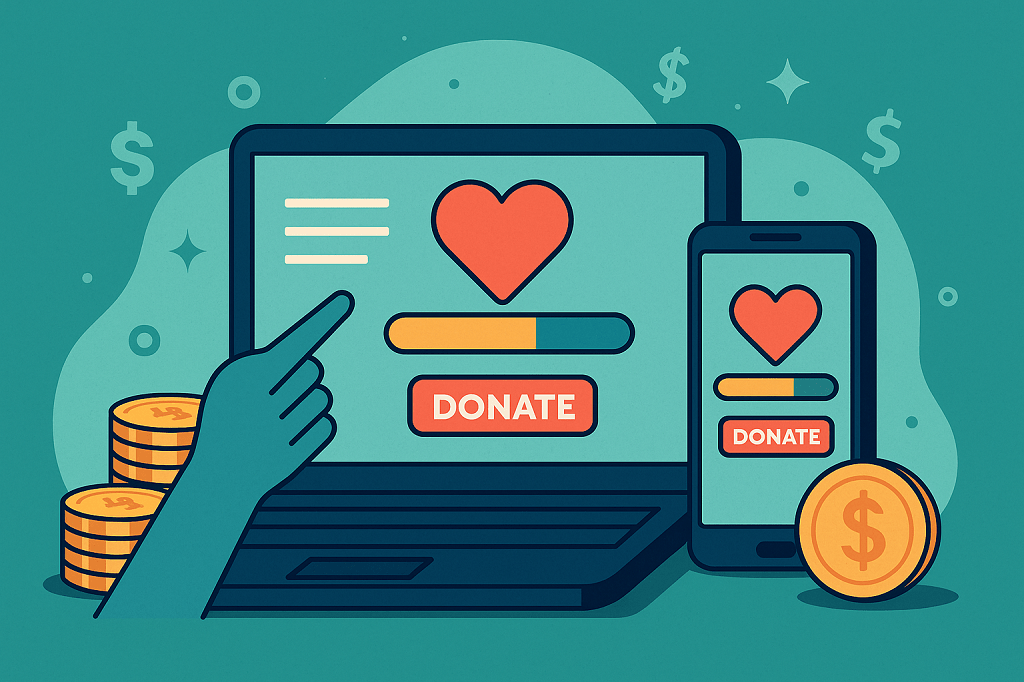
It’s easy to get caught up in features and pricing grids, but real insight comes from seeing what people are actually doing. In 2025, fundraising is more personal, more creative, and more embedded in everyday life than ever. Here’s how individuals and organizations are putting the best tools to work — and why it’s working.
A Nonprofit Goes Recurring with Donorbox
An animal shelter in Colorado shifted from one-off donation drives to a recurring giving model using Donorbox. With embedded donation forms, integrated email campaigns, and supporter tiers, they now cover monthly food and vet bills with predictable income. It’s not flashy — it’s stable. And that’s the difference between surviving and scaling.
A Musician Crowdfunds a Tour with Givebutter
For indie musicians, touring is expensive and unpredictable. Instead of relying on ticket sales alone, Chicago-based artist Lena used Givebutter to crowdfund her regional tour. She livestreamed rehearsals, offered exclusive tracks for donations, and used Venmo for fast, mobile-friendly giving. Her audience didn’t just donate — they got involved in the process.
A Local Art Collective Runs a Virtual Auction with BetterWorld
A creative collective in Toronto hosted a virtual auction and art raffle using BetterWorld. The platform’s zero-fee model and built-in support for giveaways made it easy to run a hybrid event — half online, half in-person — without extra costs. They raised over $15,000 in one weekend and built a mailing list of committed supporters for future projects.
A Student Group Raises for Charity with Facebook Fundraisers
A university service club wanted to raise money for a local food bank but didn’t have the time or resources to build a full campaign. They launched a Facebook Fundraiser, encouraged members to share it on their timelines, and tapped into birthdays and Instagram stories to boost awareness. Within 10 days, they exceeded their $3,000 goal — with no fees, no overhead, and a ton of engagement.
From small collectives to serious nonprofits, the message is the same: the fundraising game in 2025 is about meeting your audience where they already are — on mobile, in stories, during live events. The tools are there. It’s how you use them that makes the difference.
Limitations of Off-the-Shelf Platforms
Let’s be honest: plug-and-play platforms are great — until they’re not. They get you up and running fast, but sooner or later, you hit the walls. And once you do, those walls can be hard to break through.
Most fundraising platforms give you a corner of their world, not a world of your own. You can customize a headline, maybe pick a theme color, upload a photo — and that’s about where your freedom ends. The campaign still lives inside someone else’s ecosystem, under their branding, their layout, and their rules.
You want flexibility? Here’s where it gets frustrating.
You Can’t Build a Fundraising Ecosystem When You’re Just Renting Space
Maybe you want to go beyond one-time donations. You want to livestream a fundraising event. Or run an AI-driven Q&A with your donors. Maybe you want to sell content, offer perks, or launch a fan club that supports you monthly. Now you’re stitching together half a dozen tools — none of which talk to each other.
This patchwork setup not only creates friction for your supporters, but it’s exhausting for you. And let’s not forget: all that valuable donor data? You often can’t export it. Some platforms even block you from seeing full email addresses unless donors opt in. That’s a problem if you’re trying to build real, lasting relationships — not just collect one-time donations.
And the bigger you get, the harder it is to scale inside someone else’s system. Want to remove their branding? Pay more. Want to run a campaign they don’t approve of? Good luck. If the platform goes down or pivots strategy, your entire fundraising machine is vulnerable.
At some point, the question becomes: why not just build it yourself?
That’s exactly what we’re covering next — how to stop piecing things together and start building something truly yours.
Scrile Connect: Build a Platform That’s Yours, Not Theirs
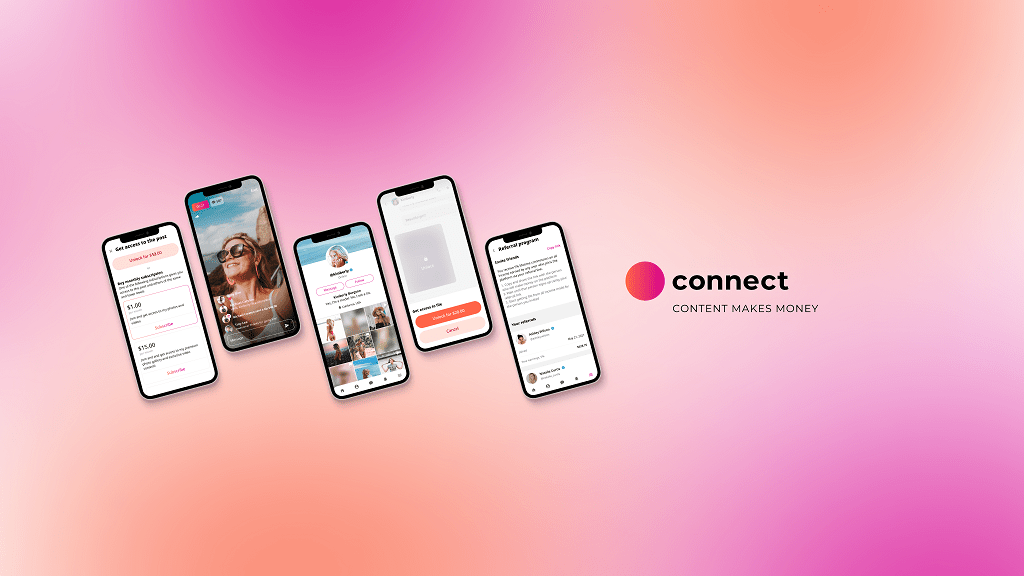
If you’ve ever looked at a donation page and thought, “This isn’t really me,” then Scrile Connect might be exactly what you’ve been waiting for. It’s not another plug-and-play fundraising app — it’s a fully customizable development service that helps you build your own fundraising platform from scratch.
That means no templates, no limitations, and no sharing your audience with a big marketplace. You decide what your platform looks like, how it works, and how your supporters engage with it.
Scrile Connect isn’t about collecting tips — it’s about building a digital home base for your mission, community, or brand.
Fundraising That Feels Like a Full Experience
Where most tools stop at donation forms, Scrile Connect opens up a full ecosystem. Imagine combining content, communication, and revenue in one place — with zero outside branding, no distracting ads, and full control over the features you offer.
You could host a live-streamed fundraiser, let supporters chat with an AI persona tied to your mission, offer exclusive content behind a paywall, sell merch, or build a fan club with monthly tiers. This is next-level fundraising — designed to match how people actually engage in 2025.
What Sets Scrile Connect Apart
Here’s what you can build into your fundraising experience — all under your own name, logo, domain and donor strategy:
🎥 Live Streaming with Tipping
Run real-time fundraising events, Q&As, or behind-the-scenes broadcasts. Enable per-minute billing, ticketed entry, and interactive tipping during streams.
💬 Direct Donor Messaging
Build personal relationships with your top supporters. Send updates, respond to messages, or offer private thank-yous via paid, private chat—all tracked in your dashboard.
🧾 Tiered Subscriptions
Convert one-time donors into recurring backers with membership tiers that unlock exclusive content, early updates, or donor recognition badges.
📅 Paid Events & Appointments
Host exclusive webinars, community roundtables, or video calls with prepaid ticketing. Great for donor briefings, virtual galas, or expert Q&As.
🎯 Tip Goals & Post Tipping
Motivate your audience with goal-driven campaigns and micro-donations on individual posts—ideal for viral giving moments or milestone-based projects.
🖼 Paid Content & Updates
Monetize exclusive blog posts, project updates, behind-the-scenes videos, or downloadable resources. Let supporters pay for the impact they want to see.
📊 Full Admin Control & Analytics
Track donations, monitor supporter behavior, moderate comments, and control platform features from one intuitive backend. Your platform, your data.
Every feature works seamlessly together—no third-party logins, disconnected tools, or branding you don’t control. With Scrile Connect, you own your fundraising journey from start to finish.
Stop adapting to someone else’s system. Start building your own fundraising platform—with tools designed for how donors give in 2025.
If you’ve tried all the “best online fundraising platforms” and still feel boxed in, maybe it’s time to stop trying to fit the mold — and start building your own.
Fundraising Platform Comparison at a Glance (2025)
| Platform | Platform Fees | Custom Branding | Monetization Tools | Livestreaming | Donor Data Access |
|---|---|---|---|---|---|
| GoFundMe | 2.9% + $0.30 | ❌ Limited | ❌ Basic | ❌ No | ❌ Limited |
| BetterWorld | 0% (tipping) | ⚠️ Partial | 🎁 Events, Raffles | ❌ No | ⚠️ Partial |
| Donorbox | 1.5% | ⚠️ Some | 🧾 Recurring Gifts | ❌ No | ✅ Yes |
| Givebutter | 0% (tipping) | ⚠️ Limited | 🎥 Video-first | ✅ Yes | ⚠️ Partial |
| Scrile Connect | 0% | ✅ Full | ✅ Subscriptions, PPV, Tips | ✅ Yes | ✅ Full |
Tired of limits? Scrile Connect lets you build your own branded fundraising platform with full control.
What’s Next? Fundraising Isn’t Slowing Down
If the last few years have taught us anything, it’s that fundraising is no longer confined to galas, cold emails, or awkward pitches. It’s now creator-first, content-driven, and built around ongoing community. And we’re only just scratching the surface.
Expect to see online giving platforms evolve rapidly — or get left behind. Donors are used to fast, personalized experiences in every area of life. They’re not going to tolerate clunky donation forms or one-size-fits-all campaigns anymore. That means platforms need to get smarter, faster, and far more adaptable.
One of the biggest shifts in 2025? Fundraisers are looking more like creators — and vice versa. A growing number of artists, educators, coaches, and activists are now monetizing content while also inviting supporters to contribute to a larger mission. It’s no longer just about “donate now.” It’s buy this, watch that, join here — and yes, give if you believe in it.
We’re also seeing the rise of hybrid campaigns that blend media, commerce, and community. Think: a limited merch drop tied to a fundraising goal, or a livestream event with tipping and digital downloads built in. These aren’t things traditional fundraising tools were built to handle — but that’s exactly what modern fundraisers need.
Then there’s the AI layer. Early adopters are already experimenting with AI chatbots that answer donor questions, recommend giving options, or even walk someone through a pledge process in real time. It’s engagement without the burnout — and it’s becoming a must-have, not a gimmick.
Most importantly, the shift toward white-label ecosystems is only accelerating. More organizations are waking up to the value of owning their own infrastructure. Why compete on a crowded platform with someone else’s logo, terms, and traffic rules when you can build your own? Custom-built platforms aren’t just a vanity move — they’re a long-term strategy for survival and growth.
The future of fundraising belongs to those who adapt. The fundraising tools that will lead the next decade won’t be the flashiest — they’ll be the most flexible. They’ll meet users where they are, not the other way around.
Conclusion: It’s Not About the Platform — It’s About Control
Let’s call it like it is: platforms like GoFundMe are great if you need to launch a campaign fast. Same with BetterWorld, Donorbox, and other best online donation platforms for nonprofits — they’ve earned their place by helping people raise real money for real causes.
But if you’re here to build something more permanent — a community, a content-driven experience, a brand — you’re going to hit the ceiling fast.
That’s where control comes in. Real fundraising power isn’t just about the tools you use — it’s about how much freedom they give you. Can you brand it your way or scale it? Can you own the data, the experience, the future?
The best online fundraising platforms in 2025 don’t just collect donations — they give creators, nonprofits, and organizers a stage to build movements.
If you’ve hit the limits of off-the-shelf tools, maybe it’s time to stop adapting to someone else’s system — and start building your own.
Whether you’re running a grassroots movement, nonprofit, or creator-driven community—Scrile Connect gives you the tools to own your platform, data, and revenue.
Schedule a free consultation to explore our pre-built solutions now.
FAQ
Which online fundraising site is best?
GoFundMe still leads for speed and social proof. You can launch in minutes, tap a 150 M-user donor base, and withdraw funds daily—ideal for urgent personal or medical campaigns.
Is there a better website than GoFundMe?
BetterWorld is a strong alternative if you need auctions, giveaways, or peer-to-peer events. It runs on optional tips (no platform fees) but offers less built-in traffic, so promotion falls on you.
Which social media platform is best for fundraising?
Facebook—its 3 B-user reach, viral sharing, and zero fees for most nonprofit donations make it the top funnel, though customization and donor-data access are limited.
Can I build a GoFundMe alternative for my niche?
Yes. Scrile Connect lets you launch a white-label fundraising site with your own branding, payment rails, and donor analytics—perfect for local causes or creator-driven hubs.
How long does it take to launch a fundraising website?
With Scrile Connect’s pre-built architecture, you can customise and go live in a few weeks—far faster than coding from scratch—so you start raising funds sooner.
Read Also
| Link | Why to read |
|---|---|
| Subscription Fan Club Platforms | Convert donors into members with recurring benefits. |
| Patreon Alternative | Compare pledge-based vs. donation-based economics. |
| White-Label Influencer Platform | Build a branded donation portal with creator storefronts. |
| White-Label Social Media App | Use social features to amplify reach and campaign virality. |
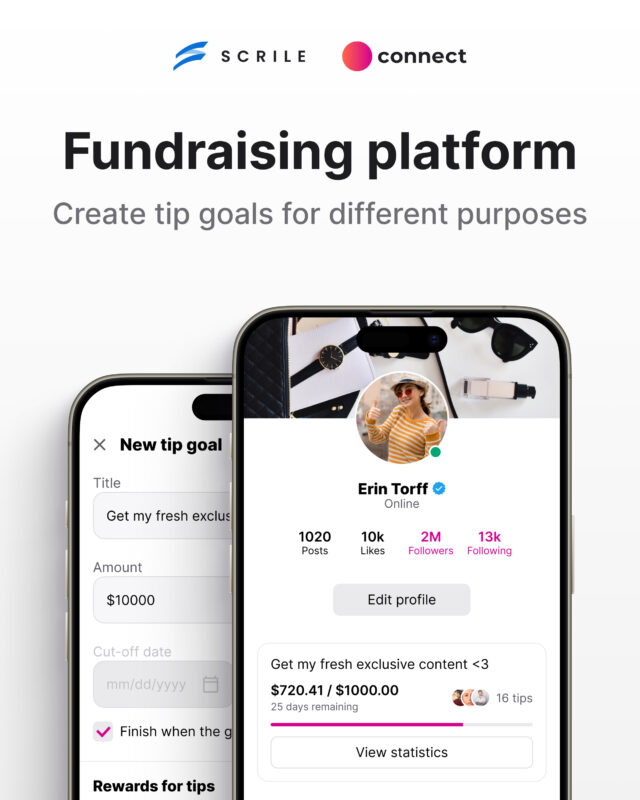
Loved the part about hybrid campaigns — I’ve been doing livestream fundraisers and totally agree they work better now 🎶💛
The examples make it so real. The art collective story gave me chills — that’s the future of fundraising for creatives. 🎨✨
This article nails how fundraising has evolved! The “experience over donation” idea really resonates. 👏
Finally, someone explained the downsides of GoFundMe clearly 😅 I’ve hit those limits myself.
Great breakdown! I didn’t know BetterWorld was zero-fee — bookmarking this for our next community drive 🙌